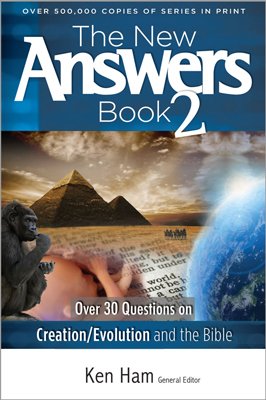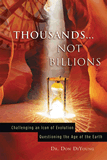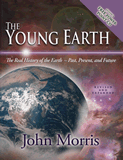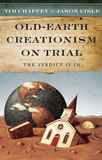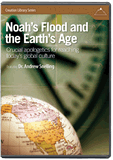
Chapter 19
How Old Is the Earth?
How old is the earth? The question of the age of the earth has produced heated discussions on internet debate boards, TV, radio, in classrooms, and in many churches, Christian colleges, and seminaries. The primary sides are
- Young-earth proponents (biblical age of the earth and universe of about 6,000 years)1
- Old-earth proponents (secular age of the earth of about 4.5billion years and a universe about 14 billion years old)2
The difference is immense! Let’s give a little history of where these two basic calculations came from and which worldview is more reasonable when answering the question, "how old is the earth?"
Where Did a Young-earth Worldview Come From?
Simply put, it came from the Bible. Of course, the Bible doesn’t say explicitly anywhere, “The earth is 6,000 years old.” Good thing it doesn’t; otherwise it would be out of date the following year. But we wouldn’t expect an all-knowing God to make that kind of a mistake.
God gave us something better. In essence, He gave us a “birth certificate.” For example, using a personal birth certificate, a person can calculate how old he is at any point. It is similar with the earth. Genesis 1 says that the earth was created on the first day of creation (Genesis 1:1–5). From there, we can begin to calculate the age of the earth.
Let’s do a rough calculation to show how this works. The age of the earth can be estimated by taking the first five days of creation (from earth’s creation to Adam), then following the genealogies from Adam to Abraham in Genesis 5 and 11, then adding in the time from Abraham to today.
Adam was created on day 6, so there were five days before him. If we add up the dates from Adam to Abraham, we get about 2,000 years, using the Masoretic Hebrew text of Genesis 5 and 11.3 Whether Christian or secular, most scholars would agree that Abraham lived about 2,000 B.C. (4,000 years ago).
So a simple calculation is:
5 days
+ ~2,000 years
+ ~4,000 years
~6,000 years
At this point, the first five days are negligible. Quite a few people have done this calculation using the Masoretic text (which is what most English translations are based on) and with careful attention to the biblical details, they have arrived at the same time frame of about 6,000 years, or about 4000 B.C. Two of the most popular, and perhaps best, are a recent work by Dr. Floyd Jones4 and a much earlier book by Archbishop James Ussher5 (1581–1656). See table 1.
Table 1. Jones and Ussher
| Name | Age Calculated | Reference and Date |
|---|---|---|
| Archbishop James Ussher | 4004 B.C. | The Annals of the World, A.D. 1658 |
| Dr. Floyd Nolan Jones | 4004 B.C. | The Chronology of the Old Testament, A.D. 1993 |
The misconception exists that Ussher and Jones were the only ones to arrive at a date of 4000 B.C.; however, this is not the case at all. Jones6 lists several chronologists who have undertaken the task of calculating the age of the earth based on the Bible, and their calculations range from 5501 to 3836 B.C. A few are listed in table 2.
Table 2. Chronologists’ Calculations According to Dr. Jones
| Chronologist | When Calculated? | Date B.C. | |
|---|---|---|---|
| 1 | Julius Africanus | c. 240 | 5501 |
| 2 | George Syncellus | c. 810 | 5492 |
| 3 | John Jackson | 1752 | 5426 |
| 4 | Dr William Hales | c. 1830 | 5411 |
| 5 | Eusebius | c. 330 | 5199 |
| 6 | Marianus Scotus | c. 1070 | 4192 |
| 7 | L. Condomanus | n/a | 4141 |
| 8 | Thomas Lydiat | c. 1600 | 4103 |
| 9 | M. Michael Maestlinus | c. 1600 | 4079 |
| 10 | J. Ricciolus | n/a | 4062 |
| 11 | Jacob Salianus | c. 1600 | 4053 |
| 12 | H. Spondanus | c. 1600 | 4051 |
| 13 | Martin Anstey | 1913 | 4042 |
| 14 | W. Lange | n/a | 4041 |
| 15 | E. Reinholt | n/a | 4021 |
| 16 | J. Cappellus | c. 1600 | 4005 |
| 17 | E. Greswell | 1830 | 4004 |
| 18 | E. Faulstich | 1986 | 4001 |
| 19 | D. Petavius | c. 1627 | 3983 |
| 20 | Frank Klassen | 1975 | 3975 |
| 21 | Becke | n/a | 3974 |
| 22 | Krentzeim | n/a | 3971 |
| 23 | W. Dolen | 2003 | 3971 |
| 24 | E. Reusnerus | n/a | 3970 |
| 25 | J. Claverius | n/a | 3968 |
| 26 | C. Longomontanus | c. 1600 | 3966 |
| 27 | P. Melanchthon | c. 1550 | 3964 |
| 28 | J. Haynlinus | n/a | 3963 |
| 29 | A. Salmeron | d. 1585 | 3958 |
| 30 | J. Scaliger | d. 1609 | 3949 |
| 31 | M. Beroaldus | c. 1575 | 3927 |
| 32 | A. Helwigius | c. 1630 | 3836 |
As you will likely note from table 2, the dates are not all 4004 B.C. There are several reasons chronologists have different dates,7 but two primary reasons:
- Some used the Septuagint or another early translation instead of the Hebrew Masoretic text. The Septuagint is a Greek translation of the Hebrew Old Testament, done about 250 B.C. by about 70 Jewish scholars (hence it is often cited as the LXX, which is the Roman numeral for 70). It is good in most places, but appears to have a number of inaccuracies. For example, one relates to the Genesis chronologies where the LXX indicates that Methuselah would have lived past the Flood, without being on the ark!
- Several points in the biblical time-line are not straightforward to calculate. They require very careful study of more than one passage. These include exactly how much time the Israelites were in Egypt and what Terah’s age was when Abraham was born. (See Jones’s and Ussher’s books for a detailed discussion of these difficulties.)
The first four in table 2 (bolded) are calculated from the Septuagint, which gives ages for the patriarchs’ firstborn much higher than the Masoretic text or the Samarian Pentateuch (a version of the Old Testament from the Jews in Samaria just before Christ). Because of this, the Septuagint adds in extra time. Though the Samarian and Masoretic texts are much closer, they still have a few differences. See table 3.8
Using data from table 2 (excluding the Septuagint calculations and including Jones and Ussher), the average date of the creation of the earth is 4045 B.C. This still yields an average of about 6,000 years for the age of the earth.
Table 3. Septuagint, Masoretic, and Samarian Early Patriarchal Ages at the Birth of the Following Son
| Name | Masoretic | Samarian Pentateuch | Septuagint |
|---|---|---|---|
| Adam | 130 | 130 | 230 |
| Seth | 105 | 105 | 205 |
| Enosh | 90 | 90 | 190 |
| Cainan | 70 | 70 | 170 |
| Mahalaleel | 65 | 65 | 165 |
| Jared | 162 | 62 | 162 |
| Enoch | 65 | 65 | 165 |
| Methuselah | 187 | 67 | 167 |
| Lamech | 182 | 53 | 188 |
| Noah | 500 | 500 | 500 |
Extra-biblical Calculations for the Age of the Earth
Cultures throughout the world have kept track of history as well. From a biblical perspective, we would expect the dates given for creation of the earth to align more closely to the biblical date than billions of years.
This is expected since everyone was descended from Noah and scattered from the Tower of Babel. Another expectation is that there should be some discrepancies about the age of the earth among people as they scattered throughout the world, taking their uninspired records or oral history to different parts of the globe.
Under the entry “creation,” Young’s Analytical Concordance of the Bible9 lists William Hales’s accumulation of dates of creation from many cultures, and in most cases Hales says which authority gave the date. See table 4.
Historian Bill Cooper’s research in After the Flood provides intriguing dates from several ancient cultures.10 The first is that of the Anglo-Saxons, whose history has 5,200 years from creation to Christ, according to the Laud and Parker Chronicles. Cooper’s research also indicated that Nennius’s record of the ancient British history has 5,228 years from creation to Christ. The Irish chronology has a date of about 4000 B.C. for creation, which is surprisingly close to Ussher and Jones! Even the Mayans had a date for the Flood of 3113 B.C.
This meticulous work of many historians should not be ignored. Their dates of only thousands of years are good support for the biblical date of about 6,000 years, but not for billions of years.
Table 4. Selected Dates for the Age of the Earth by Various Cultures
| Culture | Age, B.C. | Authority listed by Hales |
|---|---|---|
| Spain by Alfonso X | 6984 | Muller |
| Spain by Alfonso X | 6484 | Strauchius |
| India | 6204 | Gentil |
| India | 6174 | Arab records |
| Babylon | 6158 | Bailly |
| Chinese | 6157 | Bailly |
| Greece by Diogenes Laertius | 6138 | Playfair |
| Egypt | 6081 | Bailly |
| Persia | 5507 | Bailly |
| Israel/Judea by Josephus | 5555 | Playfair |
| Israel/Judea by Josephus | 5481 | Jackson |
| Israel/Judea by Josephus | 5402 | Hales |
| Israel/Judea by Josephus | 4698 | University history |
| India | 5369 | Megasthenes |
| Babylon (Talmud) | 5344 | Petrus Alliacens |
| Vatican (Catholic using the Septuagint) | 5270 | N/A |
| Samaria | 4427 | Scaliger |
| German, Holy Roman Empire by Johannes Kepler* | 3993 | Playfair |
| German, reformer by Martin Luther* | 3961 | N/A |
| Israel/Judea by computation | 3760 | Strauchius |
| Israel/Judea by Rabbi Lipman* | 3616 | University history |
* Luther, Kepler, Lipman, and the Jewish computation likely used biblical texts to determinethe date.
The Origin of the Old-earth Worldview
Prior to the 1700s, few believed in an old earth. The approximate 6,000-year age for the earth was challenged only rather recently, beginning in the late 18th century. These opponents of the biblical chronology essentially left God out of the picture. Three of the old-earth advocates included Comte de Buffon, who thought the earth was at least 75,000 years old. Pièrre LaPlace imagined an indefinite but very long history. And Jean Lamarck also proposed long ages.11
However, the idea of millions of years really took hold in geology when men like Abraham Werner, James Hutton, William Smith, Georges Cuvier, and Charles Lyell used their interpretations of geology as the standard, rather than the Bible. Werner estimated the age of the earth at about one million years. Smith and Cuvier believed untold ages were needed for the formation of rock layers. Hutton said he could see no geological evidence of a beginning of the earth; and building on Hutton’s thinking, Lyell advocated “millions of years.”
From these men and others came the consensus view that the geologic layers were laid down slowly over long periods of time based on the rates at which we see them accumulating today. Hutton said:
The past history of our globe must be explained by what can be seen to be happening now. . . . No powers are to be employed that are not natural to the globe, no action to be admitted except those of which we know the principle.12
This viewpoint is called naturalistic uniformitarianism, and it excludes any major catastrophes such as Noah’s flood. Though some, such as Cuvier and Smith, believed in multiple catastrophes separated by long periods of time, the uniformitarian concept became the ruling dogma in geology.
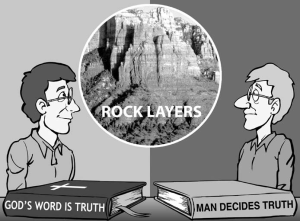
Thinking biblically, we can see that the global flood in Genesis 6–8 would wipe away the concept of millions of years, for this Flood would explain massive amounts of fossil layers. Most Christians fail to realize that a global flood could rip up many of the previous rock layers and redeposit them elsewhere, destroying the previous fragile contents. This would destroy any evidence of alleged millions of years anyway. So the rock layers can theoretically represent the evidence of either millions of years or a global flood, but not both. Sadly, by about 1840, even most of the Church had accepted the dogmatic claims of the secular geologists and rejected the global flood and the biblical age of the earth.
After Lyell, in 1899, Lord Kelvin (William Thomson) calculated the age of the earth, based on the cooling rate of a molten sphere, at a maximum of about 20–40 million years (this was revised from his earlier calculation of 100 million years in 1862).13 With the development of radiometric dating in the early 20th century, the age of the earth expanded radically. In 1913, Arthur Holmes’s book, The Age of the Earth, gave an age of 1.6 billion years.14 Since then, the supposed age of the earth has expanded to its present estimate of about 4.5 billion years (and about 14 billion years for the universe).
Table 5. Summary of the Old-earth Proponents for Long Ages
| Who? | Age of the Earth | When Was This? |
|---|---|---|
| Comte de Buffon | 78 thousand years old | 1779 |
| Abraham Werner | 1 million years | 1786 |
| James Hutton | Perhaps eternal, long ages | 1795 |
| Pièrre LaPlace | Long ages | 1796 |
| Jean Lamarck | Long ages | 1809 |
| William Smith | Long ages | 1835 |
| Georges Cuvier | Long ages | 1812 |
| Charles Lyell | Millions of years | 1830–1833 |
| Lord Kelvin | 20–100 million years | 1862–1899 |
| Arthur Holmes | 1.6 billion years | 1913 |
| Clair Patterson | 4.5 billion years | 1956 |
But there is growing scientific evidence that radiometric dating methods are completely unreliable.15
Christians who have felt compelled to accept the millions of years as fact and try to fit them into the Bible need to become aware of this evidence. It confirms that the Bible’s history is giving us the true age of the creation.
Today, secular geologists will allow some catastrophic events into their thinking as an explanation for what they see in the rocks. But uniformitarian thinking is still widespread, and secular geologists will seemingly never entertain the idea of the global, catastrophic flood of Noah’s day.
The age of the earth debate ultimately comes down to this foundational question: Are we trusting man’s imperfect and changing ideas and assumptions about the past? Or are we trusting God’s perfectly accurate eyewitness account of the past, including the creation of the world, Noah’s global flood, and the age of the earth?
Other Uniformitarian Methods for Dating the Age of the Earth
Radiometric dating was the culminating factor that led to the belief in billions of years for earth history. However, radiometric dating methods are not the only uniformitarian methods. Any radiometric dating model or other uniformitarian dating method can and does have problems, as referenced before. All uniformitarian dating methods require assumptions for extrapolating present-day processes back into the past. The assumptions related to radiometric dating can be seen in these questions:
- Initial amounts?
- Was any parent amount added?
- Was any daughter amount added?
- Was any parent amount removed?
- Was any daughter amount removed?
- Has the rate of decay changed?
If the assumptions are truly accurate, then uniformitarian dates should agree with radiometric dating across the board for the same event. However, radiometric dates often disagree with one another and with dates obtained from other uniformitarian dating methods for the age of the earth, such as the influx of salts into the ocean, the rate of decay of the earth’s magnetic field, and the growth rate of human population.16
The late Dr. Henry Morris compiled a list of 68 uniformitarian estimates for the age of the earth by Christian and secular sources.17 The current accepted age of the earth is about 4.54 billion years based on radiometric dating of a group of meteorites,18 so keep this in mind when viewing table 6.
Table 6. Uniformitarian Estimates Other than Radiometric Dating Estimates for Earth’s Age Compiled by Morris
| 0 – 10,000 years | >10,000 – 100,000 years | >100,000 – 1 million years | >1 million – 500 million years | >500 million – 4 billion years | >4 billion – 5 billion years | |
| Number of uniformitarian methods* | 23 | 10 | 11 | 23 | 0 | 0 |
|---|
* When a range of ages is given, the maximum age was used to be generous to the evolutionists. In one case, the date was uncertain so it was not used in this tally, so the total estimates used were 67. A few on the list had reference to Saturn, the sun, etc., but since biblically the earth is older than these, dates related to them were used.
As you can see from table 6, uniformitarian maximum ages for the earth obtained from other methods are nowhere near the 4.5 billion years estimated by radiometric dating; of the other methods, only two calculated dates were as much as 500 million years.
The results from some radiometric dating methods completely undermine those from the other radiometric methods. One such example is carbon-14 (14C) dating. As long as an organism is alive, it takes in 14C and 12C from the atmosphere; however, when it dies, the carbon intake stops. Since 14C is radioactive (decays into 14N), the amount of 14C in a dead organism gets less and less over time. Carbon-14 dates are determined from the measured ratio of radioactive carbon-14 to normal carbon-12 (14C/12C). Used on samples that were once alive, such as wood or bone, the measured 14C/12C ratio is compared with the ratio in living things today.
Now, 14C has a derived half-life of 5,730 years, so the 14C in organic material supposedly 100,000 years old should all essentially have decayed into nitrogen.19 Some things, such as wood trapped in lava flows, said to be millions of years old by other radiometric dating methods, still have 14C in them.20 If the items were really millions of years old, then they shouldn’t have any traces of 14C. Coal and diamonds, which are found in or sandwiched between rock layers allegedly millions of years old, have been shown to have 14C ages of only tens of thousands of years.21 So which date, if any, is correct? The diamonds or coal can’t be millions of years old if they have any traces of 14C still in them. This shows that these dating methods are completely unreliable and indicates that the presumed assumptions in the methods are erroneous.
Similar kinds of problems are seen in the case of potassium-argon dating, which has been considered one of the most reliable methods. Dr. Andrew Snelling, a geologist, points out several of these problems with potassium-argon, as seen in table 7.22
These and other examples raise a critical question. If radiometric dating fails to give an accurate date on something of which we do know the true age, then how can it be trusted to give us the correct age for rocks that had no human observers to record when they formed? If the methods don’t work on rocks of known age, it is most unreasonable to trust that they work on rocks of unknown age. It is far more rational to trust the Word of the Godwho created the world, knows its history perfectly, and has revealed sufficient information in the Bible for us to understand that history and the age of the creation.
Table 7. Potassium-argon (K-Ar) Dates in Error
| Volcanic eruption | When the rock formed | Date by (K-Ar) radiometric dating |
|---|---|---|
| Mt. Etna basalt, Sicily | 122 B.C. | 170,000–330,000 years old |
| Mt. Etna basalt, Sicily | A.D. 1972 | 210,000–490,000 years old |
| Mount St. Helens, Washington | A.D. 1986 | Up to 2.8 million years old |
| Hualalai basalt, Hawaii | A.D. 1800–1801 | 1.32–1.76 million years old |
| Mt. Ngauruhoe, New Zealand | A.D. 1954 | Up to 3.5 million years old |
| Kilauea Iki basalt, Hawaii | A.D. 1959 | 1.7–15.3 million years old |
Conclusion: How Old Is The Earth?
When we start our thinking with God’s Word, we see that the world is about 6,000 years old. When we rely on man’s fallible (and often demonstrably false) dating methods, we can get a confusing range of ages from a few thousand to billions of years, though the vast majority of methods do not give dates even close to billions.
Cultures around the world give an age of the earth that confirms what the Bible teaches. Radiometric dates, on the other hand, have been shown to be wildly in error.
The age of the earth ultimately comes down to a matter of trust—it’s a worldview issue. Will you trust what an all-knowing God says on the subject, or will you trust imperfect man’s assumptions and imaginations about the past that regularly are changing?
Thus says the Lord: “Heaven is My throne, and earth is My footstool. Where is the house that you will build Me? And where is the place of My rest? For all those things My hand has made, and all those things exist,” says the Lord. “But on this one will I look: On him who is poor and of a contrite spirit, and who trembles at My word” (Isaiah 66:1–2).
The New Answers Book 2
In The New Answers Book 2 you’ll find 31 more great answers to big questions for the Christian life.
Read Online Buy BookFootnotes
- Not all young-earth creationists agree on this age. Some believe that there may be small gaps in the genealogies of Genesis 5 and 11 and put the maximum age of the earth at about 10,000–12,000 years. However, see chapter 5, “Are There Gaps in the Genesis Genealogies?”
- Some of these old-earth proponents accept molecules-to-man biological evolution and so are called theistic evolutionists. Others reject neo-Darwinian evolution but accept the evolutionary timescale for stellar and geological evolution, and hence agree with the evolutionary order of events in history.
- Russell Grigg, “Meeting the Ancestors,” Creation, March 2003, pp. 13–15.
- Floyd Nolan Jones, Chronology of the Old Testament (Green Forest, AR: Master Books, 2005).
- James Ussher, The Annals of the World, transl. Larry and Marion Pierce (Green Forest, AR: Master Books, 2003).
- Jones, Chronology of the Old Testament, p. 26
- Others would include gaps in the chronology based on the presences of an extra Cainan in Luke 3:36. But there are good reasons this should be left out. See chapters 5, “Are There Gaps in the Genesis Genealogies?” and 27, “Isn’t the Bible Full of Contradictions?”
- Jonathan Sarfati, “Biblical Chronogenealogies,” TJ 17, no. 3 (2003):14–18.
- Robert Young, Young’s Analytical Concordance to the Bible (Peabody, MA: Hendrickson, 1996), referring to William Hales, A New Analysis of Chronology and Geography, History and Prophecy, vol. 1 (1830), p. 210.
- Bill Cooper, After the Flood (UK: New Wine Press, 1995), p. 122–129.
- Terry Mortenson, “The Origin of Old-earth Geology and its Ramifications for Life in the 21st Century,” TJ 18, no. 1 (2004): 22–26, online at https://answersingenesis.org/age-of-the-earth/origin-of-old-earth-geology-and-ramifications-for-21st-century/.
- James Hutton, Theory of the Earth (Trans. of Roy. Soc. of Edinburgh, 1785); quoted in A. Holmes, Principles of Physical Geology (UK: Thomas Nelson & Sons Ltd., 1965), p. 43–44.
- Mark McCartney, “William Thompson: King of Victorian Physics,” Physics World, December 2002, physicsworld.com/cws/article/print/16484.
- Terry Mortenson, “The History of the Development of the Geological Column,” in The Geologic Column, eds. Michael Oard and John Reed (Chino Valley, AZ: Creation Research Society, 2006) https://answersingenesis.org/age-of-the-earth/the-history-of-the-development-of-the-geological-column/.
- For articles at the layman’s level, see Radiometric Dating For a technical discussion, see Larry Vardiman, Andrew Snelling, and Eugene Chaffin, eds., Radioisotopes and the Age of the Earth, vol. 1 and 2 (El Cajon, CA: Institute for Creation Research; Chino Valley, AZ: Creation Research Society, 2000 and 2005). See also “Half-Life Heresy,” New Scientist, October, 21 2006, pp. 36–39, abstract online at www.newscientist.com/channel/fundamentals/mg19225741.100-halflife-heresy-acceleratingradioactive-decay.html.
- Russell Humphrey, “Evidence for a Young World,” Impact, June 2005, online at https://answersingenesis.org/astronomy/age-of-the-universe/evidence-for-a-young-world/.
- Henry M. Morris, The New Defender’s Study Bible (Nashville, TN: World Publishing, 2006), p. 2076–2079.
- C.C. Patterson, “Age of Meteorites and the Age of the Earth,” Geochemica et Cosmochemica Acta, 10 (1956): 230–237.
- This does not mean that a 14C date of 50,000 or 100,000 would be entirely trustworthy. I am only using this to highlight the mistaken assumptions behind uniformitarian dating methods.
- Andrew Snelling, “Conflicting ‘Ages’ of Tertiary Basalt and Contained Fossilized Wood, Crinum, Central Queensland Australia,” Technical Journal 14, no. 2 (2005): p. 99–122.
- John Baumgardner, “14C Evidence for a Recent Global Flood and a Young Earth,” in Radioisotopes and the Age of the Earth: Results of a Young-Earth Creationist Research Initiative, ed. Vardiman et al. (Santee, CA: Institute for Creation Research; Chino Valley, AZ: Creation Research Society, 2005), p. 587–630.
- Andrew Snelling, “Excess Argon: The ‘Achilles’ Heel’ of Potassium-Argon and Argon-Argon Dating of Volcanic Rocks,” Impact, January 1999, online at www.icr.org/article/436.
Recommended Resources

Answers in Genesis is an apologetics ministry, dedicated to helping Christians defend their faith and proclaim the good news of Jesus Christ.
- Customer Service 800.778.3390
- © 2024 Answers in Genesis

